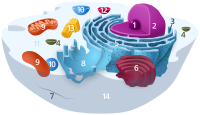
Photo from wikipedia
Mutations in Na‐K‐2Cl co‐transporter, NKCC2, lead to type I Bartter syndrome (BS1), a life‐threatening kidney disease. Yet, our knowledge of the molecular regulation of NKCC2 mutants remains poor. Here, we… Click to show full abstract
Mutations in Na‐K‐2Cl co‐transporter, NKCC2, lead to type I Bartter syndrome (BS1), a life‐threatening kidney disease. Yet, our knowledge of the molecular regulation of NKCC2 mutants remains poor. Here, we aimed to identify the molecular pathogenic mechanisms of one novel and three previously reported missense NKCC2 mutations. Co‐immunolocalization studies revealed that all NKCC2 variants are not functional because they are not expressed at the cell surface due to retention in the endoplasmic reticulum (ER). Cycloheximide chase assays together with treatment by protein degradation and mannose trimming inhibitors demonstrated that the defect in NKCC2 maturation arises from ER retention and associated degradation (ERAD). Small interfering RNA (siRNA) knock‐down experiments revealed that the ER lectin OS9 is involved in the ERAD of NKCC2 mutants. 4‐phenyl butyric acid (4‐PBA) treatment mimicked OS9 knock‐down effect on NKCC2 mutants by stabilizing their immature forms. Importantly, out of the four studied mutants, only one showed an increased protein maturation upon treatment with glycerol. In summary, our study reveals that BS1 is among diseases linked to the ERAD pathway. Moreover, our data open the possibility that maturation of some ER retained NKCC2 variants is correctable by chemical chaperones offering, therefore, promising avenues in elucidating the molecular pathways governing the ERAD of NKCC2 folding mutants.
Journal Title: Human Mutation
Year Published: 2021
Link to full text (if available)
Share on Social Media: Sign Up to like & get
recommendations!